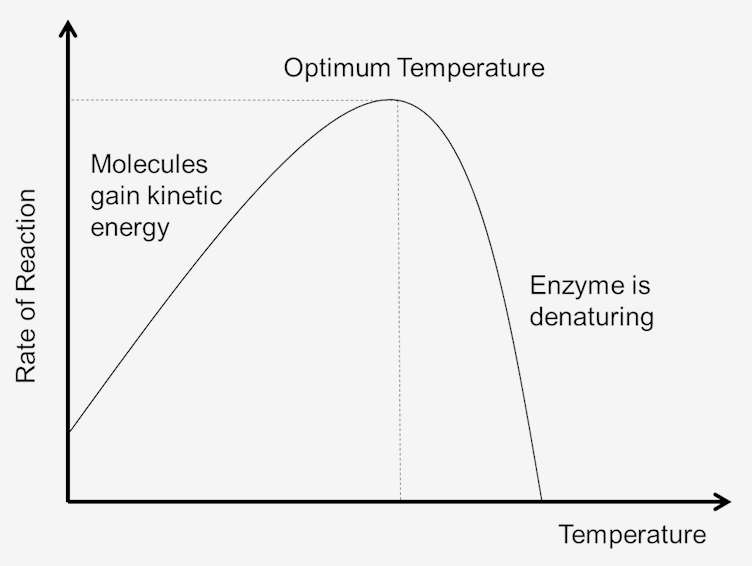What Temperature Is Enzyme Activity the Best
Every enzyme has an optimum temperature. Each enzyme has an optimal temperature range meaning the enzyme has highest activity somewhere near the middle of that range.

Factors Affecting Enzyme Activity A Level Notes
If the temperature is decreased and increased the efficiency of the enzyme decreases and there is a decrease in reaction rate.

. The results showed that N fertilization 75 kg N ha. Thus immobilized enzyme broadens the pH range of this reaction. This can be different from one enzyme to the next but enzymes within the human body tend to have optimum temperatures around 37C.
Two new thermal parameters Teq and Delta Heq describe the active-inactive transition and enable a complete description of the effect of temperature on enzyme activity. If the temperature around an enzyme gets too high the enzyme loses its shape which is known as denaturation and ceases to work. And auxiliary variables soil temperature and moisture were simultaneously measured.
If the temperature decreases then the enzymes will not. Any decrease in rate at higher temperatures that is caused by an increase in Km at higher temperatures is a potential source of large errors. The rate of reaction increases with an increase of temperature as the heat enhances the kinetic energy of the enzyme and substrate molecules.
Animals in desert climates have enzymes adapted to higher temperatures. High Temperatures Enzymes are. NH4N and NO3N in soil.
For many biological reactions the optimum temperature is at physiological conditions which is around 37texto textC which is normal body temperature. In the human body the optimal temperature at which most enzymes become highly active lies in the range of 95F to 104F. Although increased temperatures can cause enzymes to work more quickly if the temperature gets too high the enzyme stops working.
So in a sense an enzymes ideal temperature is dictated by the coding of that enzyme which does not vary a great deal from person to person. The optimum temperature for human enzymes is around 40 degrees Celsius hence the normal body temperature of a human is 375 degrees Celsius. The model describes the effect of temperature on enzyme activity in terms of a rapidly reversible active-inactive transition in addition to an irreversible thermal inactivation.
For example Arctic animals have enzymes adapted to lower optimal temperatures. Elevation of temperature lowers what is. Up to 10 cash back The immobilized enzyme has about 80 relative enzyme activity at pH 79 and the free enzyme has 100 and 69 relative enzyme activity at pH 10 and 105 while it only has about 40 maximum relative enzyme activity at other pH conditions.
This is because the temperature has the ability to change the structure of enzymes and make them. On the other hand in low temperature conditions the reaction becomes slow. Activity is reached at the enzymes optimum temperature.
As the temperature increases so does the rate of enzyme activity. Most enzymes will become denatured at very high temperatures. If the temperature is too far below or too high above this range the enzyme stops working.
Soil enzyme activity may be an important regulatory factor for C exchange from temperate artificial grassland soil in response to N fertilization. The optimum temperature for most enzymes is about 986 degrees Fahrenheit 37 degrees Celsius. There are also enzymes that work well at lower and higher temperatures.
Enzymes will work best if. The temperature at which the enzyme activity is greatest. Enzymes work fastest when they are at the optimum temperature but as the temperature gets lower the enzymes activity begins.
Since Km values for enzymes tend to rise with temperature 7 8 in some cases dramatically this is particularly important. The temperature that causes the most activity is called the optimum temperature Bliss C Fesuk S. Generally as the temperature rises the efficiency of the the enzyme will increase also.
That depends on the enzyme and the environment it is working in. Many enzymes lose function at lower and higher temperatures. And it just so happens that most of the important bodily enzymes function best at or near 986 degrees Fahrenheit.
At higher temperatures an enzymes shape deteriorates.

Temperature Enzyme Reaction Rates Effects Examples Expii

Effect Of Temperature On Enzymatic Reaction Creative Enzymes


No comments for "What Temperature Is Enzyme Activity the Best"
Post a Comment